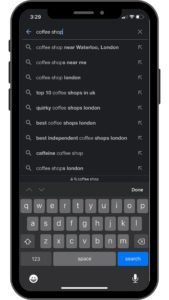An SEO Guide Guaranteed For Success
Jul 16, 2021
Social Media Marketing News

Search Engine Optimization. It’s one of those terms that is always flying around the internet. But what does it really mean?
Today, an SEO strategy is more than just optimising your website’s content so as to increase the likelihood of showing up in search results. A successful SEO strategy allows your content to be seen by those who want it most.
To help you understand all the ins and outs of SEO strategy, we have created a beginners guide to SEO. Let’s dive in and get your site out there.
MOBILE SEO GUIDE
Before we get into the SEO basics, let’s take a look at mobile SEO strategy.
When indexing and ranking pages for SERPS, Google uses the mobile version of sites first. Thus, ensuring that your site and all its content is available and accessible for mobile users is incredibly important.
To achieve mobile optimisation, there are three main things you need to track.
First is page speed. Essentially, just make sure that your page is optimised for speed so that it loads quickly and faultlessly.
Second up, is responsive site design. This means that your site will shift the way it looks to fit the device it is being viewed on. Rather than loading up the computer version of a site on a mobile device, a mobile specific site will be used.
Finally, we have local SEO. Up to 46% of Google searches are seeking local information and local SEO ensures that your site caters to this. To employ local SEO simply optimise your site for local searches.

SEO STARTER GUIDE
What comes to mind when you think of SEO? Most likely, you think about plugging in specific keywords throughout your site. Whilst this is a small part of this broader topic, there are actually three main areas of SEO for you to understand.
On-page SEO
On-page SEO is the most basic form of SEO. It is what comes to mind for most people when they imagine a SEO guide.
On-page SEO refers to the content on your site that aims to boost its ranking for certain keywords. For example, if you are aiming to rank competitively for the keyword “marketing guide,” then on-page SEO will see you mention this term many times across your page.
Off-page SEO
Off-page SEO refers to links in other places on the internet that refer back to your own site. These links are called backlinks and they help establish your site as trustworthy. The more backlinks you have from reputable sites, the more the search algorithm will trust your site.
Technical SEO
Technical SEO is particularly important for rankings. Google’s algorithms look into your site’s technical set-up as well as your content, so having optimised site architecture (such as your site code) is essential.

OFFICIAL SEO GUIDE
Ensuring that your site is following a SEO guide to the best of your ability can seem like a tall task. But trust us, once it’s all broken down it’s as simple as can be.
Search your head term on Google
The first step in our SEO guide is searching your head term on Google. Your head term is the general word or phrase that describes your company. For example, if you run a coffee shop, then your head term will be “coffee shop”.
Head terms are typically quite difficult to rank for as they are incredibly broad and thus have a large number of visits monthly. In spite of this, it is still important to take note of what other sites you are competing with under this head term.
Look through Google’s suggested searches and filters
Having a look through Google’s suggested searches and filters is a great way to get a lay of the land.
This step is essential to any SEO guide, as, by noticing what Google is suggesting, you can determine what people are searching for that’s related to you. On top of this, you can determine what would these people find most useful and if you have a helpful product or service for them.
Following on with our coffee shop example, if the suggested searches are things like vegan coffee shops, you can angle your business and site to these terms so as to appease your customers.

Search the SERPS
Next up in our SEO guide is SERPS.
Have a look through the results that pop up when you search your head term. Then, try and go a few filters deep and take note of what sites are there. Once you’ve done this, you can start to develop a long-tailed keyword for your business. A long-tailed keyword is a longer, more specific phrase that refers to your business. Such as, “vegan London coffee shop”.
When analysing the SERPS for your head term, be sure to ask yourself how many others are trying to rank for this term and what sorts of people are trying (are they big companies or small ones?). Also, take note of what’s in the upper fold and what SERP features Google includes (SERP features are things like “sources from across the web” panels and “people also ask” boxes).
If it feels like there is just too much competition for your keyword, it may be worth searching for another, more specific long-tailed keyword. By making your search more specific, you will likely have less competition.

Scope out the competition
Once you have a keyword in mind, next up in our SEO guide is scoping out your main competitors. Have a look at what categories they include on their sites and what sort of content they publish. By analysing your competitors, you have a better chance of succeeding them.
However, because Google is just so dang good at what it does, beating out the competition takes more than simply outranking them. You have to consider website age, authority, experience and website structure. Looking into these factors helps you understand what Google is favouring, and thus what is most important to include on your site.
Don’t be tempted to simply copy categories from your top competitors. Rather, focus on which top categories your brand can do best.
Generate online authority
Generating online authority via EEAT is a key piece in any SEO guide.
EEAT is an SEO formula that ensures your site is ranking well. Broken down, it stands for expertise, experience, authority and trustworthiness.
To engage in EEAT, make sure to include your credentials in as many places on your site as possible. Interviewing experts in your niche, as well as hiring freelancers with credible names, also helps generate online authority.
Create SEO content
Creating SEO content is likely what came to mind when you began this SEO guide. To ensure your site’s content is optimised for the keywords you have chosen, include your keywords in your page title, H1, text, meta description and URL. The more mentions, the better!
On top of this, try including image alt text in your site. This not only makes your site more accessible, but it also gives your site the chance to rank in image results.
Build backlinks
Backlinks are the final step in our SEO guide. As mentioned previously, backlinks are like getting a vote from another site on your authority.
To gain backlinks, make sure you engage in activities such as publishing original research, partnering with other companies, writing help-focused content and joining industry membership organisations.
There you have it, our SEO guide guaranteed to get the right heads turning.
Our Influencer marketing agency and Social agency are located worldwide, with our agency network based in the USA, UK, UAE and China.
If you want to receive our industry insights, visit our Influencer Marketing & Social Media blog.
@ Socially Powerful
[cta]
Popular Blogs
Most Popular Instagram Hashtags | Tiktok Hashtags | Instagram Monetization | Facebook Banner Size | Snapchat Influencers | Most Subscribed Youtubers | Best Time to Post on Youtube | UK Twitch Streamers | Female Twitch Streamers | Popular Tiktok Songs | Male Tiktok Influencers | Lgbtq Tiktok Influencers | The Rise and Fall of Clubhouse | Influencer Marketing on Clubhouse | LiketoKnowit | Pretty Little Thing Instagram| Top Social Marketing Agencies
Social And Influencer Marketing News + Insights
Get in touch
We'll show you how to start powerful conversation, drive social engagement, build your brand, hit sales targets or meet other goals you have, wherever you are in the world.
Work with us





